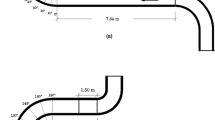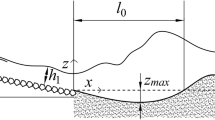Abstract
Block ramps are ecofriendly drop structures, which ensure more stability in the downstream riverbed. The scouring in the stilling basin bed material generated by the rapidly varied flow transition affects the stability of the ramp structure. In the present study, a modified stilling basin bed configuration is tested along with the uniform conventional stilling basin bed arrangements to check the stability of non-cohesive beds downstream to block ramps. Uniform non-cohesive horizontal bed configurations and bed with sill arrangement are tested for varying block ramp slopes (20% ≤ i ≥ 30%). The critical particle densimetric Froude number (Fc*) is selected as the criteria to predict the hydraulic conditions for incipient sediment motion in the uniform beds and it is compared with the established literature formulations to estimate the stability of the beds under macroroughness conditions. Scour volumes from each experimental run is quantified and the intensity of sediment motion is determined and related with the critical particle densimetric Froude number. The findings of the paper also describe the effect of Fc* on dimensionless scour depth. Spatial shift in the maximum scour depth formation from the toe of the block ramp for the tested flows over the bed sill arrangement has been observed. Experimental observations and comparison of results show the effect of sill gradation pronounced for non-uniform bed configuration, which effectively reduce the scour depth henceforth it stabilizes the upstream block ramp structure relative to the uniform beds selected.









Similar content being viewed by others
Data Availability
All data measured are presented in the figures and tables. If required, it is available upon request.
References
Oertel, M.; Bung, D.B.: Stability and scour development of bed material on crossbar block ramps. Int. J. Sedim. Res. 30(4), 344–350 (2015). https://doi.org/10.1016/j.ijsrc.2014.12.003
Aguirre Pe, J.; Olivero, M.I.A.L.; Moncada, A.T.: Particle densimetric Froude number for estimating sediment transport. J. Hydraul. Eng. 29(6), 428–437 (2003). https://doi.org/10.1061/(ASCE)0733-9429(2003)129:6(428)
Shields, A.: Anwendung der Aehnlichkeitsmechanik und der Turbulenzforschung auf die Geschiebebewegung. PhD Thesis Technical University Berlin.(1936)
Kovacs, A.; Parker, G.: A new vectorial bedload formulation and its application to the time evolution of straight river channels. J. Fluid Mech. 267, 153–183 (1994). https://doi.org/10.1017/S002211209400114X
Rajaratnam, N.; Macdougall, R.K.: Erosion by plane wall jets with minimum tailwater. J. Hydraul. Eng. 109(7), 1061–1064 (1983). https://doi.org/10.1061/(ASCE)0733-9429(1983)109:7(1061)
Hoffmans, G.J.: Jet scour in equilibrium phase. J. Hydraul. Eng. 124(4), 430–437 (1998). https://doi.org/10.1061/(ASCE)0733-9429(1998)124:4(430)
Bormann, N.E.; Julien, P.Y.: Scour downstream of grade-control structures. J. Hydraul. Eng 117(5), 579–594 (1991). https://doi.org/10.1061/(ASCE)0733-9429(1991)117:5(579)
Pagliara, S.; Palermo, M.: Equilibrium scour morphology downstream of rock sills under unsteady flow conditions. In E3S Web of Conferences, 40, 03004. EDP Sciences. (2018)
Pagliara, S.; Palermo, M.; Carnacina, I.: Scour and hydraulic jump downstream of block ramps in expanding stilling basins. J. Hydraul. Res. 47(4), 503–511 (2009). https://doi.org/10.1080/00221686.2009.9522026
Pagliara, S.; Carnacina, I.; Roshni, T.: Air-water flows in the presence of staggered and row boulders under macroroughness conditions. Water Resour. Res. (2010). https://doi.org/10.1029/2009WR008834
Pagliara, S.; Roshni, T.; Palermo, M.: Energy dissipation over large-scale roughness for both transition and uniform flow conditions. Int. J. Civil Eng. 13(3), 341–346 (2015). https://doi.org/10.22068/IJCE.13.3.341
Pagliara, S.; Carnacina, I.; Roshni, T.: Self-aeration and friction over rock chutes in uniform flow conditions. J. Hydraul. Eng. 136(11), 959–964 (2010). https://doi.org/10.1061/(ASCE)HY.1943-7900.0000270
Pagliara, S.; Carnacina, I.; Roshni, T.: Inception point and air entrainment on flows under macroroughness condition. J. Environ. Eng. 137(7), 629–638 (2011). https://doi.org/10.1061/(ASCE)EE.1943-7870.0000369
Julien, P.: River mechanics. Cambridge University Press, Cambridge New York (2002)
Pagliara, S.: Influence of sediment gradation on scour downstream of block ramps. J. Hydraul. Eng. 133(11), 1241–1248 (2007). https://doi.org/10.1061/(ASCE)0733-9429(2007)133:11(1241)
Bathurst, J.C.; Graf, W.H.; Cao, H.H.: Bed load discharge equations for steep mountain rivers. In: Thorne, C.R., Bathurst, J.C., Hey, R.D. (eds.) Sediment Transport in Gravel-Bed Rivers, pp. 453–477. Wiley, New York (1987)
Aguirre Pe, J.: Incipient erosion in high gradient open channel flow with artificial roughness elements. In: Proc. 16th Congr. Int. Assoc. Hydraul. Res. San Paulo Brazil. Vol. 2, pp. 137–180 (1975)
Aguirre Pe, J.; Fuentes, R.: Movement of big particles in steep, macro-roughstreams. IAHR, editor. IAHR, Madrid. pp. 151–158 (1991)
Aguirre Pe, J.; Fuentes, R.; Picón, G.; Moncada, A.: Estudio experimental de transporte de sedimentos grueso. In Memorias del XV Congreso Latinoamericano de Hidráulica, AIIH. Vol. 3, pp. 129-139 (1992)
Bathurst, J.C.; Graf, W.H.; Cao, H.H.: Initiation of sediment transport in steep channels with coarse bed material. In: Summer, B.M.; Muller, A. (Eds.) Mechanics of sediment transport, pp. 207–213. The Netherlands, Rotterdam (1983)
Shvidchenko, A.B.; Pender, G.: Flume study of the effect of relative depth on the incipient motion of coarse uniform sediments. Water Resour. Res. 36(2), 619–628 (2000). https://doi.org/10.1029/1999WR900312
Pagliara, S.; Hager, W. H.: Scour downstream of blockramps. In: 2nd International Conference on Scour and Erosion, Singapore, Vol. 2. (2004)
Palermo, M.; Pagliara, S.: Effect of unsteady flow conditions on scour features at low-head hydraulic structures. J. Hydro-environ. Res. 19, 168–178 (2018). https://doi.org/10.1016/j.jher.2017.04.001
Funding
This study is supported by DST-SERB under the grant number ECR/2017/000984.
Author information
Authors and Affiliations
Corresponding author
Ethics declarations
Conflict of interest
Authors would like to thank DST-SERB for providing fund to complete the work. We also declare that we do not have any commercial or associative interest that represents a conflict of interest in connection with the work submitted.
Rights and permissions
About this article
Cite this article
Rawat, V.S., Roshni, T. & Carnacina, I. Experimental study of flows over Block Ramps on stability of non-cohesive beds. Arab J Sci Eng 46, 10333–10339 (2021). https://doi.org/10.1007/s13369-021-05348-6
Received:
Accepted:
Published:
Issue Date:
DOI: https://doi.org/10.1007/s13369-021-05348-6




